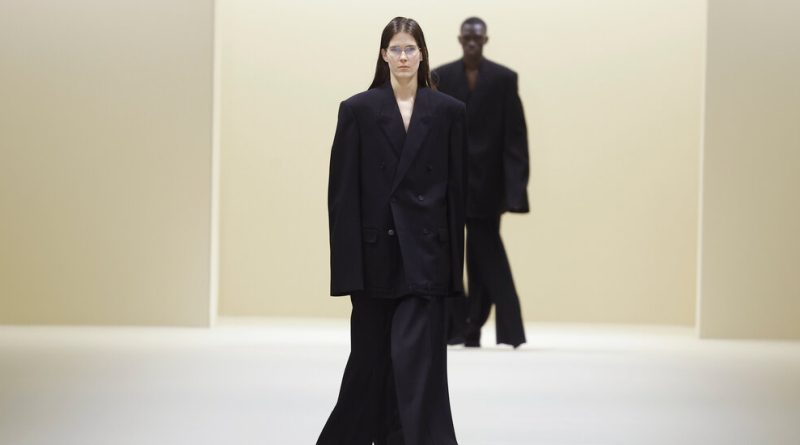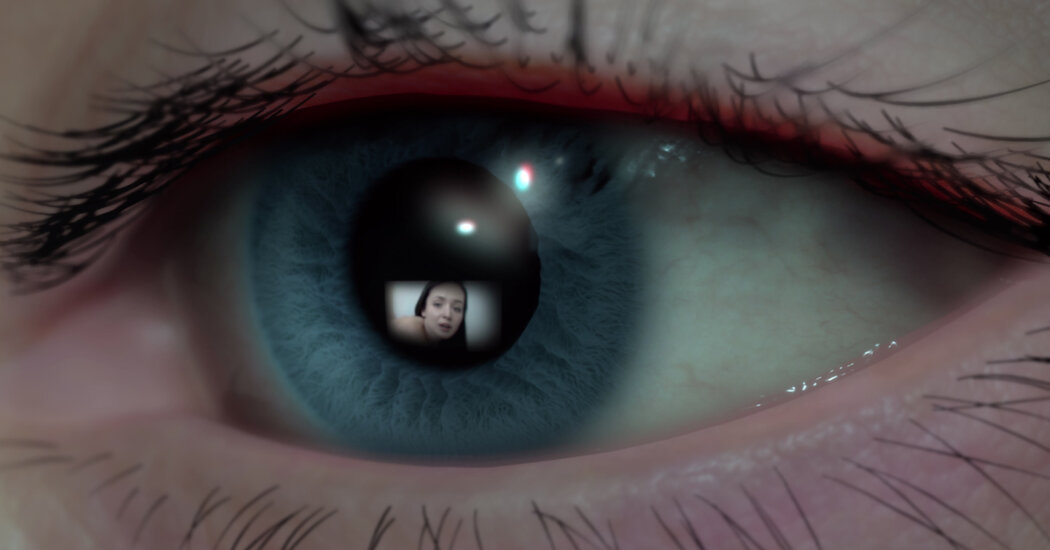Paris Fashion Week Review: Balenciaga Offers Just Clothes, and Contrition
PARIS — Can you design a redemption narrative for yourself without dramatically changing your identity?
This was the question at the heart of the Balenciaga fall 2023 show, perhaps the most high-stakes collection of the whole fashion season that began in New York on Feb. 10 and ends, finally, on March 7.
It’s also, of course, a question posed repeatedly in this particular moment, where the behavior of our sacred cows gets adjudicated in the court of public opinion, and those who rise on virality fall on it, too.
That made the Balenciaga show less of a collection than a cultural test case: essentially the black mirror version of the grand spectacles of social commentary masquerading as shows that helped drive the brand’s stratospheric success and $2 billion in annual revenues, masterminded by the brand’s mononymic creative director Demna; shows about celebrity, war, capitalism and even dirt (in all its iterations). Only this time, it was personal.
A brief recap, for those who don’t remember how we got to here.
About a month after the dirt show in October, which had been opened by Ye, the artist formerly known as Kanye West (a relationship that created its own mini-story of controversy with Ye’s subsequent White Lives Matter show and spate of anti-Semitic and anti-Black remarks), Balenciaga published two ad campaigns. Of those, one involved young children holding bags that looked like teddy bears in bondage gear; the other depicted an office in which buried in a giant mess of papers were documents about a Supreme Court case on child pornography.
A maelstrom of internet outrage, chaos and conspiracy theories ensued and took on a life of its own, with Demna and the house’s chief executive, Cédric Charbit, at its center. The brand’s seemingly unstoppable rise was halted in its tracks.
Since then they have been quietly working to put things right, including one-on-one post-mortems with industry insiders and mea culpas about the systemic and judgment failures that allowed the campaigns to happen, but the show Sunday was the biggest public statement since the furor.
It was held in the old Carrousel du Louvre, a generic convention-like area in the museum that once, briefly, had been used as the center of fashion week, before designers decided they didn’t want to share the same plain white spaces, no matter how storied the address, and started trying to one-up each other with national monuments.
This time, gone were the theatrics, the grandiose framing of Balenciaga prior. Gone were the celebrity guests.
Instead there was a claustrophobically low ceiling, a hush in the air as if everyone was holding their breath, and a long, long runway, like a road back, lined with cream-colored toile: the base material out of which fashion patterns are cut, and the fashion equivalent of the blank page.
On it, Demna offered up a collection of Just Clothes — which really means, he said in a preview, he offered up himself — set to a piece of music composed by his husband, Loïk Gomez (professional name BFRND). Mr. Gomez composed the piece when he was 12, Demna said, and had played it on their first date.
Then Demna dared everyone to judge him on his strength as a designer.
Fair enough.
According to Demna, in the depths of the brand’s crisis and his own personal despair, he retreated to his home in Switzerland with a rack of pants and started cutting them up, as he had when he was a child. “Tailoring was my therapy,” he said, so that’s where he began: with tailored daywear all made from reconfigured trousers.
There were trousers-as-jackets, the fly of the pants left open to become the vent and the waistbands turned into hems; trousers-as-trench coats, the rise of the pants turned into the flap at the back; six pairs of trousers (at least) pressed together into a sort of swinging tunic dress reminiscent of Balenciaga’s sack dress from the 1950s. Trousers layered one atop the other, so one flowed from the sides of the other like a train. If it was very Margiela-reminiscent (Margiela being a formative influence and a former employer of Demna’s), it was also newly polished.
Then came a section of leathers, puffers and denim, inflated from the inside into extreme curves and turtle shapes by the technology normally used to protect motorcyclists and skiers from crashes, which may have been a new way to put the focus on silhouette but which also seemed a metaphor too good to resist.
Next a section of haute bourgeois florals in pleated silk and leather, sleeves skimming down almost to the floor, shoulders rounded in a permanent, slightly tense, little shrug. And finally, a set of glimmering, modernist high-neck, long-sleeve evening gowns in silver, lace and beaded fringe, like wearable skyscrapers.
It was elegant. Adult. Contrite. But was it enough to stoke new desire?
Demna said pointedly that he started designing the collection six months ago — meaning before the scandal exploded. Meaning he had always planned to strip the collection back to first principles. Imagine how this show would have been received if the controversy had never happened; if it had been unveiled from his perch as high soothsayer of the industry.
People probably would have rent their garments in ecstasy over its purity; have praised to high heaven the radical nature of refusal (honestly, I might have done that). Instead, given all that had transpired, it seemed more like the march of the penitents.
Aside from those little shoulders and the fact there was not a latex mask or a sneaker in sight (and not really any branding at all), the clothes were not particularly revolutionary. Demna, as he has proved in the past, is capable of great conceptual insights — it’s how he originally transformed Balenciaga, tearing down the borders between streetwear (the stuff people actually wear) and couture, forever altering the hierarchy of value — but this didn’t meaningfully advance those ideas as much as discretely reiterate them.
Most of us don’t really know who made our clothes; we see them on a rack or in our feeds, we like them, and if we can afford them, we buy them. But when you enter the realm of high fashion, when you become a celebrity designer (even one who goes to the Met Gala in a full body mask), especially one at a heritage house with its own revered history, then who you are and what you stand for is part of the value proposition. It’s about an invitation to be part of a community. It’s about identity. It’s about want. Maybe it’s about forgiveness.
But it’s never really just about clothes.
Sahred From Source link Fashion and Style



